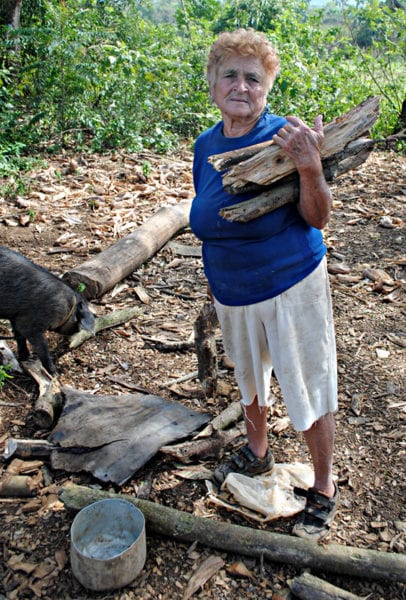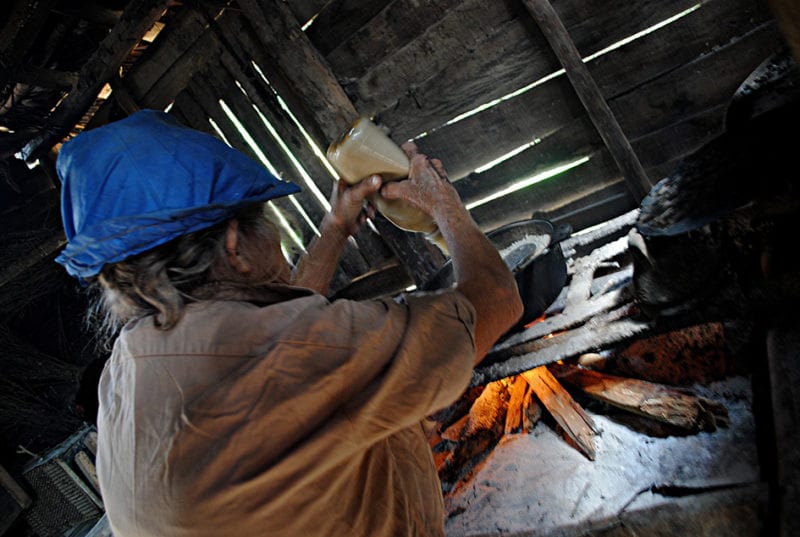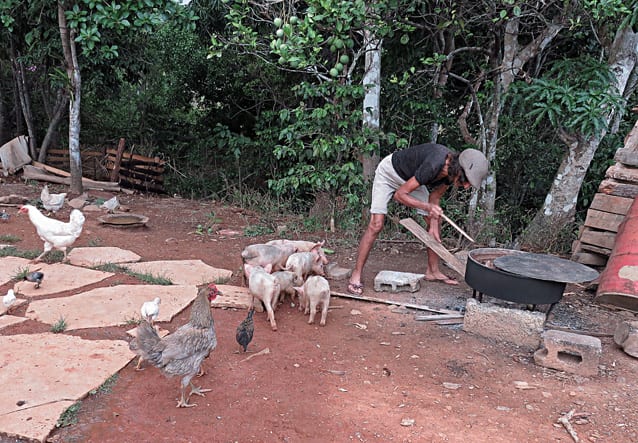Women in the Cuban Countryside
Irina Echarry

HAVANA TIMES — For an urban woman fed up of the city, its noise and pollution, living in the country can seem like a beautiful alternative. What I wouldn’t do to wake up every morning to the sounds of crickets or cicadas chirping whilst enjoying the great number of bird songs you can hear at this time of day. Who doesn’t want the privilege of gazing at the intense hues of sunsets without being disturbed by city lights?
However, it took just a few days of visiting and living with some rural families to realize that rural life isn’t all a bunch of roses; much least for women.
For quite some time now, daily routines have transformed that popular phrase which once said: the man is supposed to support the family, because women have left their homes to share public life too, working and studying as equals to men.
Furthermore, women take on their children’s education, looking after them when they’re sick and all the domestic chores, no matter how much it hurts us to admit; a large percentage of any rural household’s daily activity relies heavily on a woman.

Although there are some guajiros (farmers) who make coffee at certain times of the day, it’s the rural women who spend the majority of their day cooking. An x-ray of their lungs would show the same results as that of any hardcore smoker as kitchens mainly use wood, installed in small premises and without hardly any ventilation. Inhaling this smoke for hours on end, the female cooks are subject to chronic respiratory diseases or lung cancer, as well as allergic reactions and conjunctivitis.
Before cooking, many of them have to first look for, carry and cut wooden logs into smaller pieces to be able to light the stove. And age isn’t a factor. I’ve seen elderly women in their 70s and 80s who still do this.
 A lot of houses are also engaged in ram and pig breeding etc. Animals sleep in very close quarters to people so that they can look after and keep an eye on them. There these four-legged creatures happily urinate and shit on the single patio of the house where everyone passes by. A lot of the time, it’s the women who have to deal with the animals, feeding them, treating them and moving them around so they can eat fresh grass. The same goes for chickens, guineafowls… whatever you can think of… At sunset, just when the light is at its most beautiful, women are busy feeding animals and humans too. Most of the time, they miss seeing the beautiful twilight.
A lot of houses are also engaged in ram and pig breeding etc. Animals sleep in very close quarters to people so that they can look after and keep an eye on them. There these four-legged creatures happily urinate and shit on the single patio of the house where everyone passes by. A lot of the time, it’s the women who have to deal with the animals, feeding them, treating them and moving them around so they can eat fresh grass. The same goes for chickens, guineafowls… whatever you can think of… At sunset, just when the light is at its most beautiful, women are busy feeding animals and humans too. Most of the time, they miss seeing the beautiful twilight.
I’ve personally seen the unhappiness alcoholism creates in nearly all families. However, it’s nearly always a daily occurrence that the man gets drunk which brings out the worst in him, long-established prejudices and a most irritating state of joy. Rural women are always rubbing elbows with this drunkeness, whether it’s their husband, a brother, father or children. It always finds its way back to them and it seriously disturbs them.

Life for rural women isn’t poetic in any way, even though they don’t have to suffer the city’s aggressive nature and the hustle and bustle and even though they earn the same pay as men, they enjoy the same access to education and health services and can vote, with all of the benefits and drawbacks these issues have in the country’s social and political life.
Despite the gender equality workshops which are given at several agricultural cooperatives, women still bear the brunt of housework and family responsibility wherever they go. These workshops and some measures which aim to improve the lives of Cuban women as a whole, have helped them enter the workforce, in management roles, in jobs which aren’t typically “female”, and recognize their value as a social being. However, very few of them touch on the more personal subjects of family and tradition. In the countryside, women are still being exploited, are blamed if something goes wrong, are victims of prejudice and overburdened with work. Macho culture still gallants around the island’s rural areas, however beautiful they may be.

Does the government make you guys fill out a form for every animal born on a farm?
I think it may be that Canada and Cuba have similar problems. Just this moment I saw on Canadian television the Minister of Health, Jane Philpott, speaking about assisted dying legislation.
She says that more than half of us, particularly those in rural areas, do not have access to high quality palliative care.
What is the situation in Cuba regarding palliative care?
I think Ken that isolation has a considerable mental affect. Another factor is that in a country like Canada, many of the farmers practice mono-culture which means that there is little practical work to do for much of the year. You may have heard the comment about the lifestyle of prairie farmers being triple A: April, August, Arizona. which briefly describes sowing the crop in April, harvesting in August and then taking off as ‘snowbirds’ to Arizona for he winter. Visits to the north of Alberta, Slave Lake, Grand Prairie, the Peace River country confirm that isolation.
Similarly the many of the small (tiny, being limited to about four acres)) farmers of Cuba are isolated seldom getting to town but they do have the advantage of being kept busy because they operate a mixture of crops and livestock.
This is from a report (2009) by the Canadian Mental Health Association
The Canadian Community Health Survey (CCHS) [2002] indicates that across Canada, the self-rated health of Canadians declines from the most urban regions of the nation to the most rural and remote areas. Geographic location is thus a determinant of health. The CCHS reveals that men and women living in rural and small towns have a lower life expectancy than the average Canadian. These residents also have elevated rates of being overweight, smoking, arthritis/rheumatism and high blood pressure. Furthermore, individuals living in rural and northern areas have higher than average rates of major depressive disorder.
http://ontario.cmha.ca/public_policy/rural-and-northern-community-issues-in-mental-health/#.V1JSRyMrJP4
Just to add to what you wrote, there is another famous photograph of Fidel Castro entering Havana in a military vehicle with Huber Matos standing on his right hand side. There followed much dissension within the leaders of the revolution when the Castro brothers and Che Guevara belatedly determined that the movement was communist.
Both Camilo Cienfuegos and Huber Matos were opposed to communism. Camilo Cienfuegos disappeared in very questionable circumstances when his flight in a two seater aircraft was followed 4 minutes later by a Sea Fury fighter plane equipped with canon. The pilot of the Sea Fury was to die in an unfortunate ‘accident’ a month later (dead men tell no tales). One week after the disappearance of Cienfuegos, Huber Matos was put on trial which was personally conducted by a vindictive Fidel Castro.
Matos and 38 fellow revolutionary officers were jailed, in the case of Matos for twenty years. Both Raul Castro and Che Guevara suggested to Fidel Castro that Matos should be shot, Fidel however responded that:
“I don’t want to turn him into a Martyr.”
Following entry into Havana on 8th January, Fidel appointed Che Guevara to be in charge of ”revolutionary justice” on 12th January. Fidel then said that it wasn’t the intention to shoot more than 400, thus installing fear. Che didn’t quite manage to reach that total, but by June, had managed to execute by firing squad some 357 victims at La Cabana – now a popular tourist site, but with no plaque commemorating Che’s actions or Fidel’s instructions.
Thanks for the information about Tete Puebla, she is one of the few women to achieve prominence in the Castro regime, although almost exactly two thirds of Cuban professionally qualified citizens are women.
Carlyle, I believe “Maceo” also died fighting the Spanish. Antonio Maceo was the most famous of Mariana Grajales’ three sons. He is known as “The Bronze Titan” and he died on a Cuban battlefield in 1896 fighting the Spanish, which indeed ruled Cuba for over 400 years. That ended after the 1898 Spanish-American War, of course. In Cuba’s Revolutionary War in the 1950s, Fidel Castro famously named an all-female fighting unit “The Mariano Grajales Platoon.” The most famed fighter in that celebrated unit was the teenage Tete Puebla. Today Tete Puebla is a General in the Cuban army. There is a famous photo of Tete riding into Havana on the back of a truck with other female guerrilla fighters in January of 1959, but she had a sorrowful expression on her face that triumphal today. She explained her disappointment to the BBC this way: “I…all of us…were saddened by the fact that the Batista and Mafia leaders did not hang around Havana to fight us. They had all fled.” You can Google that photo, which is personally owned today by Tete herself.
Yes Ken, it is far too easy to forget that in the late 19th and early 20th century, immigrants from Eastern Europe most with little agricultural knowledge, were living in sod houses on the prairies of Canada. I have always admired those women who brought up families under such conditions. As the traditional area of land purchased for $10 was 160 acres, they were obviously isolated. The difference between those women in Canada over 100 years ago and the women described by Irina in current Cuba, is that in Canada there was progress and eventually reward for their struggles whereas in Cuba there is none and little hope of any being achieved. But the conditions for both sets of women has inevitably led to many having medical mental conditions.
The macho part of Cuban culture reflects that of Spain, which held Cuba in thrall for over four hundred years. Those Cuban revolutionary leaders, Cespedes, Agramonte, Marti and Maceo fought and with the exception of Maceo, died fighting the Spanish. For the peasantry of Cuba described in this touching article, little has changed since the 19th century.
The countryside can be very restful if you don’t have to struggle for your livelihood there.
But I read, decades ago. a report that problems of mental illness are often worse in the countryside than in the city. If I recall correctly, the study was looking at life in Canada.
Thanks for an illuminating article.